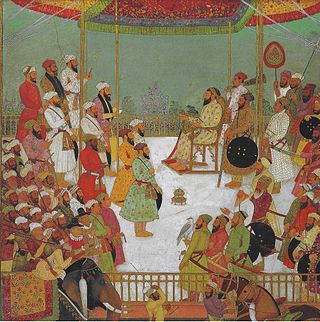Related Research Articles

Punjab is a geopolitical, cultural, and historical region in South Asia. It is specifically located in the northwestern part of the Indian subcontinent, comprising areas of modern-day eastern-Pakistan and northwestern-India. Punjab's major cities are Lahore, Faisalabad, Rawalpindi, Gujranwala, Multan, Ludhiana, Amritsar, Sialkot, Chandigarh, Shimla, Jalandhar, Patiala, Gurugram, and Bahawalpur.
The Punjabis are an Indo-Aryan ethnolinguistic group associated with the Punjab region, comprising areas of eastern Pakistan and northwestern India. They generally speak Standard Punjabi or various Punjabi dialects on both sides.

Muzaffargarh District is a district of the Punjab province of Pakistan. Its capital is Muzaffargarh city. It lies on the bank of the Chenab River.
Malhi or Mallhi is a clan of the Jat tribe in the Punjab region of Pakistan and India. They are found mostly in the Sialkot District of Punjab, Pakistan.

Chiniot is a city and the administrative headquarters of Chiniot District in the province of Punjab, Pakistan. Located on the bank of the river Chenab, it is the 28th largest city of Pakistan. It is also known for its intricate wooden furniture, architecture, and mosques, and is home to the Omar Hayat Mahal.
Muslim Rajputs or Musalman Rajpoots are the descendants of Rajputs in the northern regions of the Indian subcontinent who generally are followers of Islam. Reportedly, they converted from Hinduism to Islam from the medieval period onwards, creating various dynasties and states while retaining Hindu surnames such as Chauhan. Today, Muslim Rajputs can be found mostly in present-day Northern India and Pakistan. They are further divided into different clans.
Soomro, Soomra,Sumrah or Sumra is a tribe having a local origin in Sindh. They are found in Sindh, parts of Punjab especially bordering Sindh, Balochistan province, and the Kutch district of the Indian state of Gujarat and also Rajasthan. The Soomras ruled throughout the Sindh and Multan regions.
Kharal is a Punjabi tribe predominantly found in the Sandal Bar region of Punjab & some parts of Sindh.
The Sial or Siyal is a Punjabi clan found in the Punjab region of the Indian subcontinent, split between India and Pakistan.
The Gurjar are an Indo-Aryan agricultural ethnic community, residing mainly in India, Pakistan and Afghanistan, divided internally into various clan groups. They were traditionally involved in agriculture, pastoral and nomadic activities and formed a large heterogeneous group. The historical role of Gurjars has been quite diverse in society: at one end they have been founders of several kingdoms and dynasties and, at the other end, some are still nomads with no land of their own.
Jat Muslim or Musalman Jat, also spelled Jatt or Jutt, are an elastic and diverse ethno-social subgroup of the Jat people, who are composed of followers of Islam and are native to the northern regions of the Indian subcontinent. They are found primarily throughout the Sindh and Punjab regions of Pakistan. Jats began converting to Islam from the early Middle Ages onward and constitute a distinct subgroup within the diverse community of Jat people.

Chiniot District, is a district in the Punjab province of Pakistan. It became the district in July 2009. Before this, it was a tehsil of Jhang District.

Western Uttar Pradesh is a region in India that comprises the western districts of Uttar Pradesh state, including the areas of Rohilkhand and those where Hindi and Braj are spoken. The region has some demographic, economic and cultural patterns that are distinct from other parts of Uttar Pradesh, and more closely resemble those of Haryana and Rajasthan states. The largest city of the region is Ghaziabad, while the second-largest city, Agra, is a major tourist destination.
Punjabi Muslims are adherents of Islam who identify ethnically, linguistically, culturally, and genealogically as Punjabis. With a population of more than 109 million, they are the largest ethnic group in Pakistan and the world's third-largest Islam-adhering ethnicity after Arabs and Bengalis. The majority of Punjabi Muslims are adherents of Sunni Islam, while a minority adhere to Shia Islam. They are primarily geographically native to the Punjab province of Pakistan, but many have ancestry from the Punjab region as a whole.
The Jat people are a traditionally agricultural community in Northern India and Pakistan. Originally pastoralists in the lower Indus river-valley of Sindh, many Jats migrated north into the Punjab region in late medieval times, and subsequently into the Delhi Territory, northeastern Rajputana, and the western Gangetic Plain in the 17th and 18th centuries. Of Hindu, Muslim and Sikh faiths, they are now found mostly in the Indian states of Punjab, Haryana, Uttar Pradesh and Rajasthan and the Pakistani provinces of Sindh and Punjab.
The Lali, sometimes written as Lalee, are a Jat clan, found mainly in the Chiniot district of Punjab, Pakistan.

Sa'adullah Khan, also spelled Sadullah Khan was a noble of the Mughal Empire who served as the last grand vizier of Emperor Shah Jahan and Vakil-I-Mutlaq in the period 1645–1656.
Langah is a historical tribe and surname found in Balochistan, Sindh and south Punjab. They are considered as Jats or Rajput.
References
- ↑ "PAKISTAN: Police abduct four women amidst tribal clash". Asian Human Rights Commission. 21 October 2016. Retrieved 29 July 2022.
- ↑ Khawaja, Kamran Khamiso (26 July 2021). "Three injured in armed clash – The Pakistan Daily". The Pakistan Daily. Retrieved 29 July 2022.
- ↑ Quddus, S.A. (1992). Punjab, the Land of Beauty, Love, and Mysticism. Royal Book Company. p. 402. ISBN 978-969-407-130-5 . Retrieved 29 July 2022.
- ↑ Bhatia, S. (1987). Social Change and Politics in Punjab, 1898-1910. Enkay Publishers. p. 24. ISBN 978-81-85148-13-7 . Retrieved 29 July 2022.
The Jats were divided into several tribes . In the Western plain ( i.e. , West of Lahore ) excluding the salt range , and sub - montane tracts were to be found the Tahim , Butta , Langah , Sumra , Sipra and Hans
- ↑ Parshad, Gopal (2007). Industrial Development in Northern India: A Study of Delhi, Punjab and Haryana, 1858-1918. National Book Organisation. p. 15. ISBN 978-81-87521-20-4.